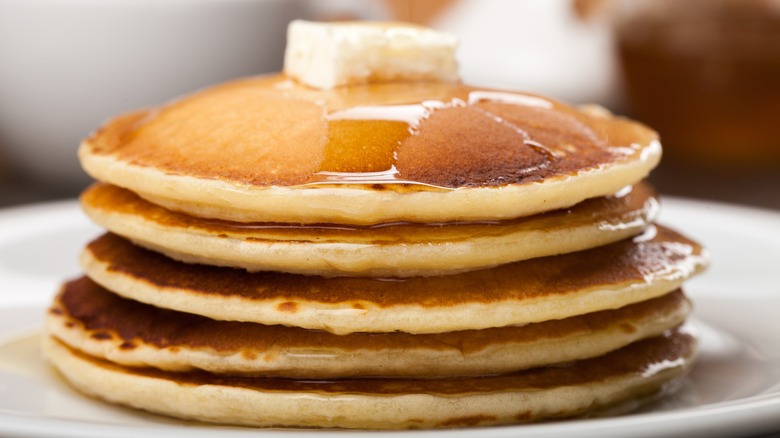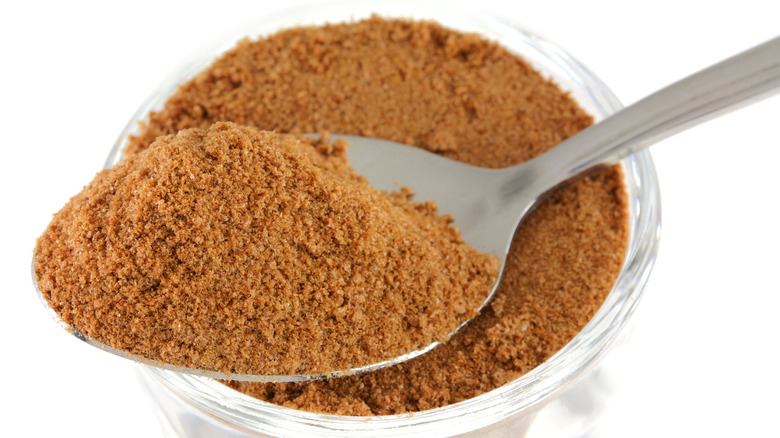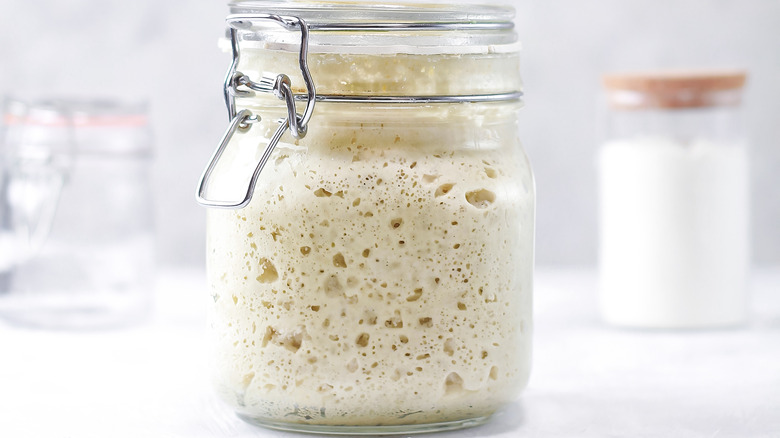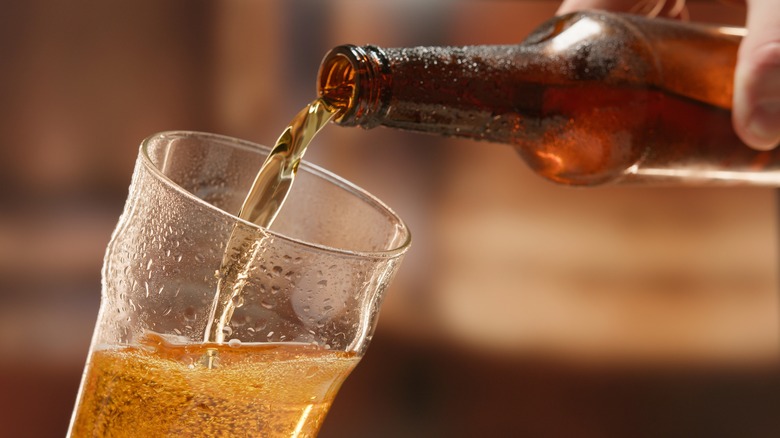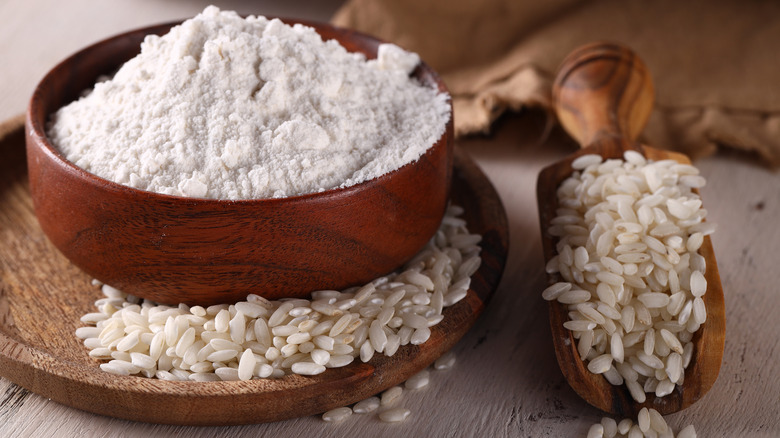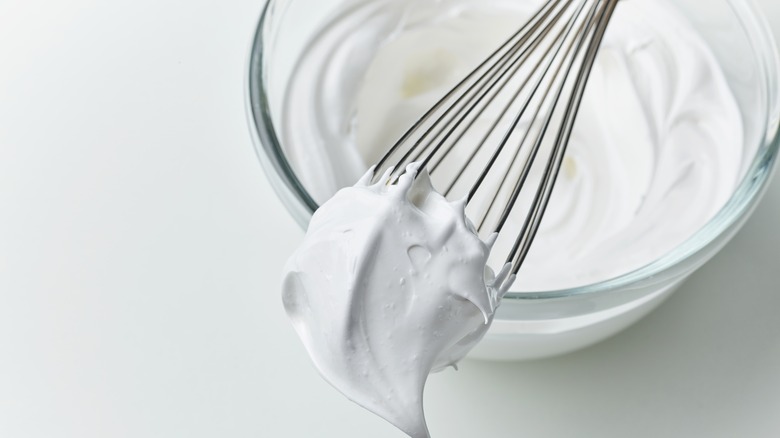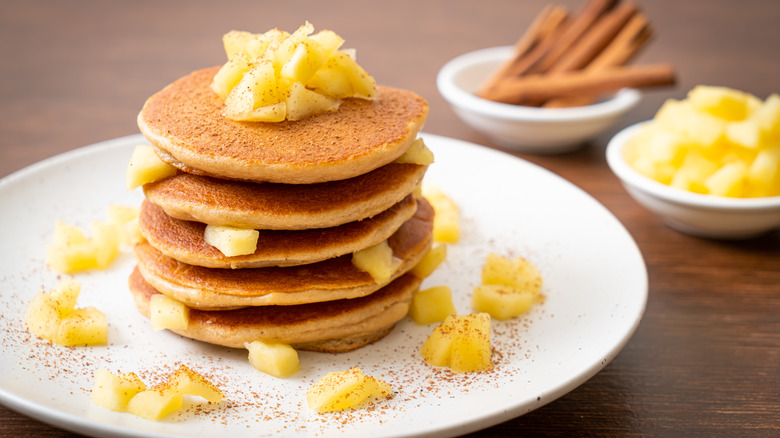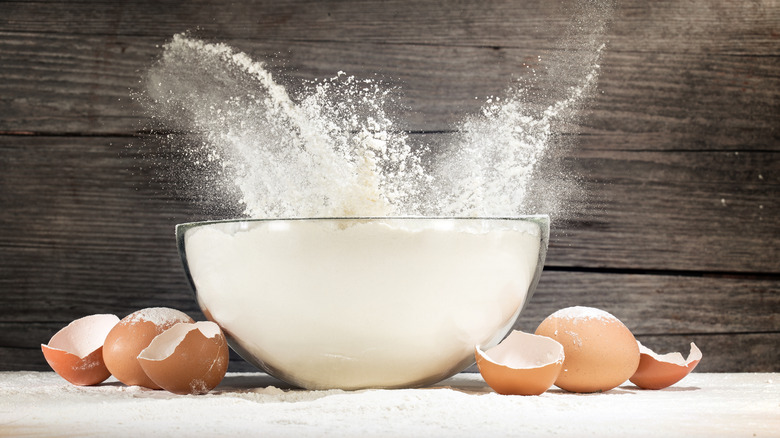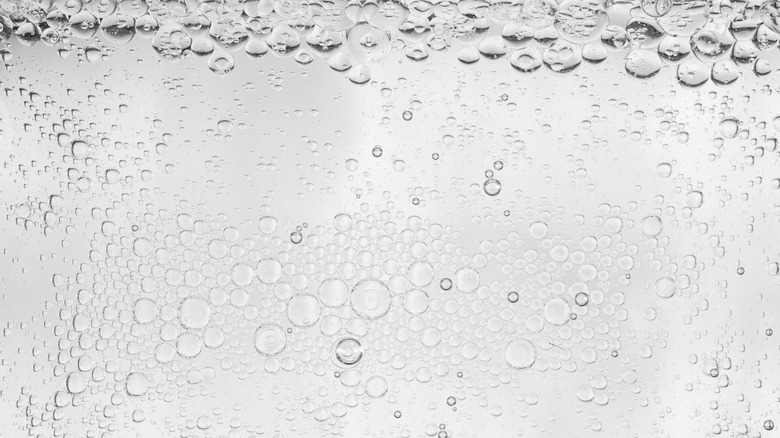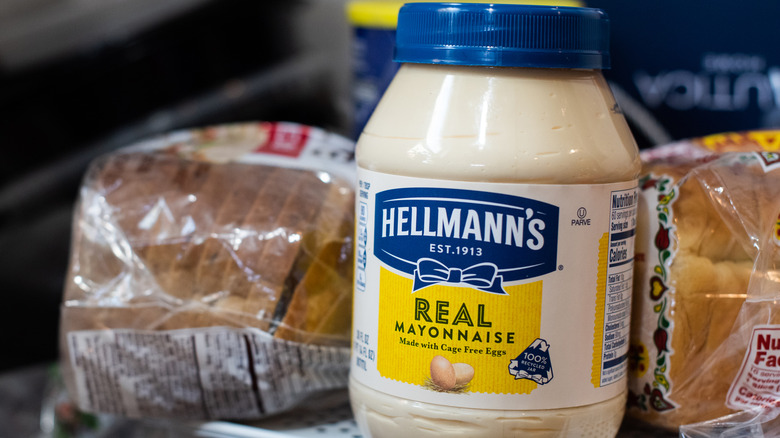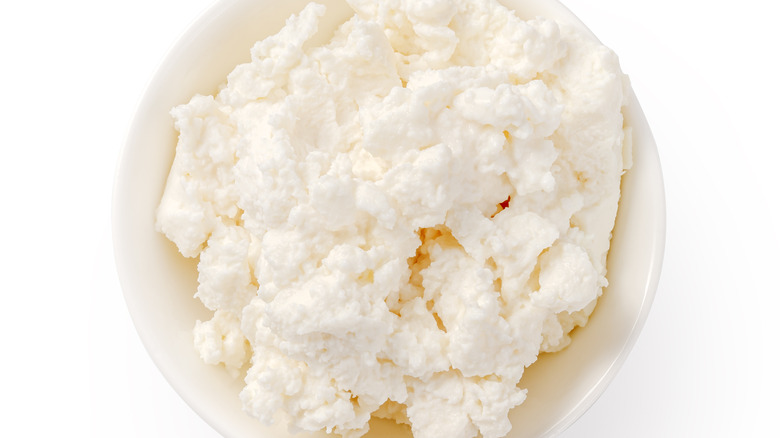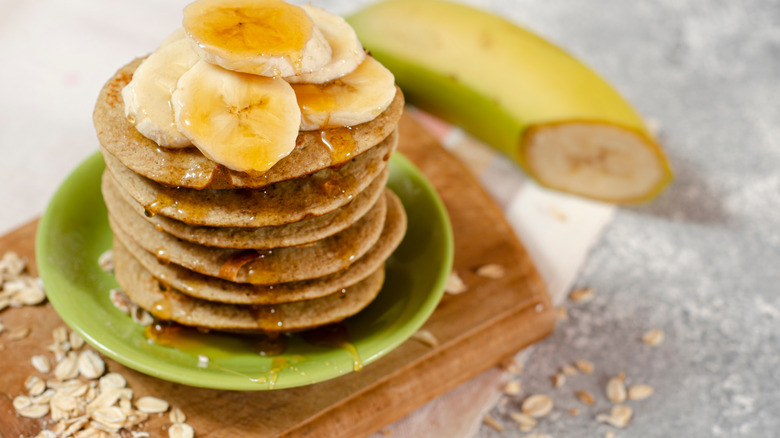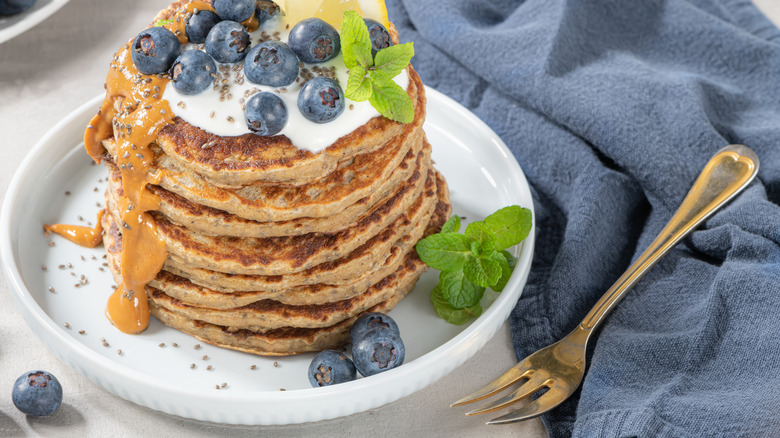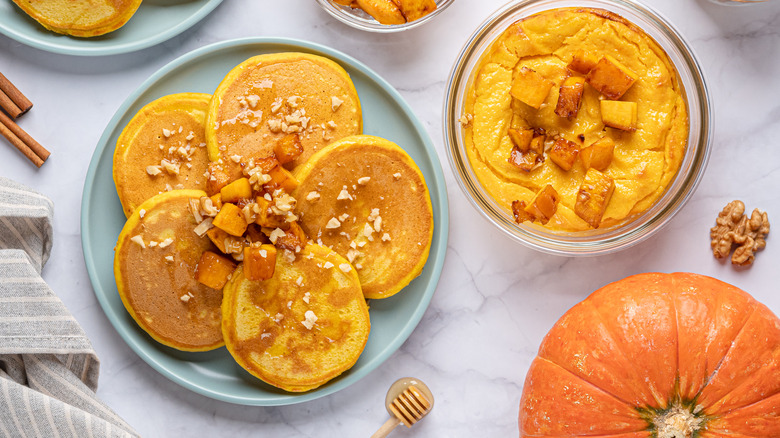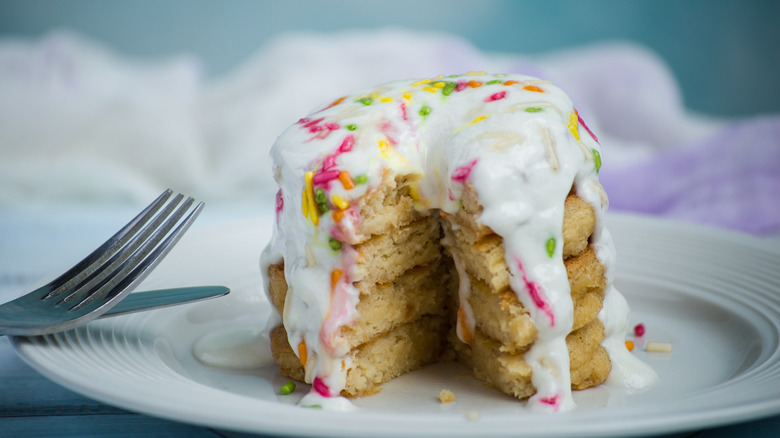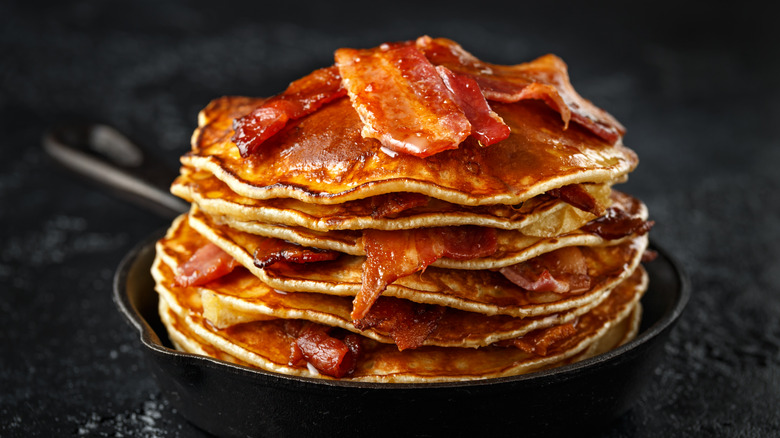15 Unexpected Ingredients That Need To Be In Your Pancakes
Pancakes are one of those quintessential breakfast foods that will always be a part of American diner culture, especially when served with scrambled eggs and a side of crispy bacon. According to National Geographic, the practice of heating a blend of water and flour goes back 30,000 years, but a version of the pancake we know today can be traced back to ancient Greek and Roman times. The pancake breakfast emerged in the 12th century as a way for people to use up leftover dairy products before Lent. By the 1800s, bakers started experimenting with a whole host of ingredients to craft the fluffiest and softest pancakes in history with the help of ingredients like baking soda, milk, and cream (via Betty Crocker).
At its core, the quintessential American pancake recipe contains flour, leavening agents, milk, and eggs mixed and cooked until golden brown on a hot skillet. But while this recipe has proven successful in homes and diners across the world, there is an underlying sense of adventure that can shine through when you play around with new ingredient additions. Here are some of the best ingredients you can add to upgrade the flavor and texture of your pancake recipe.
Malted milk powder
Malted milk powder is an unexpected ingredient to instantly upgrade your pancakes. The mix of wheat flour, barley malt extract, milk, salt, and sodium bicarbonate is on the ingredient list of many commercial pancake and waffle mixes, so you should consider adding a few tablespoons to your homemade pancake batter too. (Diners often use malted milk powder to sweeten the pancake mix rather than sugar.) You'll find the flavor of your pancakes more complex and well-rounded after adding malted milk powder.
When you look for this ingredient in the baking aisle of your grocery store, you should be sure to purchase malted milk powder, not "malt powder" or "milk powder." The former does not contain milk solids — meaning that your pancakes won't get the smooth, delectable flavor that you crave. If you accidentally purchase malt powder, you can use it for other purposes in the kitchen including coloring bagels and accelerating the rising process of certain types of bread.
Sourdough discards
If you've worked with sourdough, you can understand how disappointing it is to throw away a portion of your starter to make room for a new feeding. One creative way to use your sourdough discards is to flavor your pancake recipe. Sourdough discards that have had a long period without feeding are super tangy and acidic, thus imparting a more complex flavor to your pancake batter.
If you're using a sourdough starter, you shouldn't be afraid to allocate a big hunk — it grows back after all. Use one cup of starter for every two cups of flour in your recipe. If you want more tang, stick with a buttermilk pancake recipe. To impart the most amount of flavor into your pancakes and maximize your rise time, leave the batter in your refrigerator overnight; this will allow the wild yeast to eat the fresh flour and produce more acidic flavors and carbon dioxide.
Beer
It's five o'clock somewhere — right? While you might not be inclined to start your morning with a cold IPA, your pancakes will benefit tremendously from adding beer to your batter. Not only does this boozy trick add wheaty flavor to your batter, but the carbon dioxide from the bubbly beverage helps the batter rise.
If you want to maintain the classic diner flavor of your pancakes, you should aim for a light beer like a Blue Moon Belgian White. This popular beer is easy to find in most grocery stores and offers a mild, citrusy flavor with impeccable carbonation. If you're aiming for a malty flavor (which you should pair with malted milk powder), we recommend trying a lager such as Samuel Adams. You only need to add a few ounces of beer to the batter, not the entire bottle — too much liquid can obscure the precarious wet-dry balance in the batter.
Rice flour
Rice flour is an important ingredient for gluten-free bakers to have on hand. It also happens to be Alton Brown's secret weapon for making great pancakes. When you use gluten-based flour, such as your standard all-purpose flour, the proteins in the gluten will more easily strengthen and cause your pancake to come out rubbery and unappetizing. Brown uses a blend of white rice flour, brown rice flour, and tapioca flour to make his signature gluten-free pancakes. He also adds cornstarch, potato starch, and nonfat dry milk powder to prevent the flour from caking while using the milk powder for a diner-like flavor.
If you're using rice flour, you have to give the dough at least 30 minutes to rest. Brown notes that this time gives the starches more time to hydrate, which in turn makes the pancakes smooth rather than crunchy. Like all pancake batters, you should work quickly to cook the batter; this will prevent stodginess. Be sure to get your gluten-free pancake batter on the griddle no more than an hour after you finish preparing it.
Egg whites
If you've ever tried your hand at a soufflé pancake recipe, you know how much of an impact egg whites can have on the batter. Most batters do not require you to separate the egg whites from the yolks, but the trick for fluffier pancakes is to whisk air into the egg whites before adding them to the batter. This creates a soft, airy, and light pancake with a better rise than conventional pancake batter.
If you're set on using the same pancake batter recipe with the help of a few additional egg whites, you should add the yolks to the batter and beat the egg whites separately. The more egg whites you add, the more your batter will rise. You should also take great care to beat the whites only until stiff peaks have formed. Under-beaten egg whites are too foamy while over-beaten egg whites will separate and cause your pancake to collapse.
Spices
If you need a flavor boost, look to your spice rack. Your pancakes will taste better with a simple addition of cinnamon. You can play with different types of cinnamon to produce the flavor profile you desire. Cassia, the most common type of cinnamon sold in grocery stores in the United States, offers a subtle sweetness with a more profound hot undertone. If you want sweeter cinnamon, you'll want to stick with Ceylon cinnamon, which is floral in aroma and flavor and pairs well with other warming spices such as ground ginger, cloves, allspice, or nutmeg. Rather than mix and match, consider adding blends such as apple pie spice or pumpkin spice to your batter.
Although sweet spices are the standard for pancakes, you can also make your batter more sophisticated by adding savory notes with black pepper, oregano, and thyme. When working with savory spices, add your seasoning in small increments and pair like flavors together.
Cake flour
One of the greatest travesties in the world of pancakes is an over-worked, stodgy, and tough batter. This occurs when the gluten in the pancakes becomes overdeveloped and rigid. You can avoid this phenomenon by only mixing your batter enough to remove the pockets of dry ingredients, but not so much as to make your arm feel like it's going to fall off. You can also use low-gluten flour, such as cake flour, instead of all-purpose flour. If you want fluffy pancakes, substitute the two using a 1-to-1 ratio.
Cake flour contains between 7% and 9% gluten compared to all-purpose flour's 9% to 11%. This means that cake flour is much lighter and fluffy than all-purpose flour, which makes it an ideal flour for baking fluffy cakes. Pastry flour contains an even lower amount of protein than cake flour and is usually reserved for delicate applications where any bit of gluten development is detrimental — like a flaky croissant. If you want to get the fluffiest flour for your pancakes, you should also sift the dry ingredients together to add a bit more air.
Seltzer
Seltzer is the secret to gluten-free pancakes. Adding fizzy water to your batter works for both standard and gluten-free recipe applications. It's a better choice for recipes where you don't want to flavor your batter too much (sorry, beer), but welcome a subtle lift from the help of the seltzer's carbonation. The bubbles start to expand when heated, meaning that your pancakes will be much plusher after cooking than those without the carbonated addition. You'll just need to keep the seltzer cold to prevent releasing too many bubbles.
We recommend using original, unflavored seltzer rather than the flavored varieties. If you're making boxed pancake mix, you can substitute all of the water for equal parts seltzer. If you don't have seltzer handy, you might consider using club soda instead. Though also clear and bubbly, tonic water should be skipped since the swap could make your pancake recipe too sour.
Mayonnaise
Mayonnaise — in pancakes? While this combination may come off as obscene to pancake purists, mayo can add a substantial amount of moisture to your batter and mediate the other reactions occurring in the batter. If you think of mayonnaise less as the spread on a BLT and more as a sum of its parts — oil, eggs, and vinegar — you might think twice about adding it to your pancakes.
Adding two to three spoonfuls to the batter also helps speed up the leavening power in your recipe; this is because most mayonnaise contains vinegar. When the vinegar reacts with the baking soda, it results in a fluffier pancake. While you can just add vinegar to the recipe alone, adding mayonnaise will yield a better reaction because the egg whites in the spread capture the air bubbles and help maintain the pancake's structure. The fatty egg yolks also can help keep the gluten in the flour slack, which reduces the risk of over-beaten and stodgy pancakes.
Ricotta
Ricotta is a simple addition that will make your pancakes fluffier and lighter. This soft cheese, which is rich in vitamin D, protein, and calcium, can break up the bready texture of the pancake batter. When paired with a bit of lemon juice (and garnish of fresh lemon zest), you'll find that the flavor pops and creates a profoundly tangy undertone. You can also pair the ricotta with chocolate for a pancake twist on the cannoli.
If you're going to add ricotta, you'll need to take a couple of extra steps to ensure your pancakes don't come out too rubbery. Beat your eggs and ricotta together before adding baking powder to prevent your flapjacks from turning into fluffy soufflés. You should also gently and slowly add your flour to the batter. This will prevent too much gluten from developing and the dreaded rubbery pancake.
Oatmeal
We can all afford to add a bit more fiber to our diets — starting with the first meal of the day. Adding oatmeal to your pancakes can make them more filling, as well as provide a nutty undertone. Oatmeal is a flexible ingredient that pairs well with fruits like blueberries, bananas, and apples as well as spreads like honey, peanut butter, and Nutella.
To make oatmeal pancakes, you'll want to take an extra step and hydrate the oats before adding them to the batter. You can soak the whole rolled oats for a mere 10 minutes to help diminish the chalky taste of the whole oats. It will make the texture of the finished pancake much more seamless, too. You can complement the flavor of the oats by substituting whole wheat flour for all-purpose flour, too. Oatmeal pancakes are relatively easy to make dairy and egg-free; just substitute the milk for a non-dairy alternative and use an egg replacer.
Peanut butter
Did you know Civil Rights leader Rosa Parks' original pancake recipe included peanut butter? According to NPR, Rosa Parks loved the taste of peanut butter as an ingredient, and it was deeply tied to her identity as a Black woman from the American South. Peanuts were originally from Africa and were brought to the United States with the movement of enslaved people. The work of agriculturalists like George Washington Carver helped spawn commercial peanut cultivation and the utility of peanut butter in numerous dishes — including pancakes.
If you don't want to make your peanut butter pancakes too dense, add powdered peanut butter instead of full-fat peanut butter. You can rehydrate the peanut butter and substitute it for the regular product using a 1-to-1 ratio. If you don't mind a bit of chew in your pancake, add a few tablespoons of peanut butter with the rest of your wet ingredients. We love the taste of peanut pancakes with bananas, chocolate, or a honey drizzle.
Pumpkin puree
Autumn is the time of year for pumpkin everything. But, you should also think about cooking and baking with pumpkin puree the rest of the year too. There are plenty of reasons why you should always have canned pumpkin in your pantry. The puree is filled with beta-carotene and vitamin K — plus you can keep it around unopened for months.
We love adding pumpkin puree to our pancake recipes. On its own, pumpkin puree isn't sweet or particularly flavorful, but it is moist. You can pair pumpkin with numerous other ingredients and pancake toppings like pecans, walnuts, chocolate chips, or warming spices like cinnamon and cloves. Regardless of how you pair the pumpkin, you should add it to your batter with the rest of your wet ingredients. Since the pumpkin puree is denser compared to the heavy cream or melted butter in your recipe, you should be prepared for your pancakes to come out a bit chewier than recipes that don't use this ingredient.
Boxed cake mix
If you use this hack, you'll find that breakfast and dessert can be one-in-the-same. Adding boxed cake mix to your batter is sure to take your pancakes to the next level by elevating the sweetness of your flapjacks. You can use your favorite flavor of cake mix — we personally recommend using dark chocolate or devil's food cake for a decadent pancake breakfast. If you're using the standard size of cake mix, you can stir it into the pancake mixture as you would any other ingredient. Larger boxes of cake mix (which are greater than 15.25 ounces) mean that you can decrease the amount of flour you use in the recipe to prevent dryness.
You have a world of possibilities open to you when you add your favorite boxed mix to your pancake batter. If you love the taste of red velvet cake, you can make red velvet pancakes and prepare a cream cheese frosting to go on top. The spiced cake mix pairs well with the classic pancake topping — maple syrup.
Bacon
Bacon on the side of pancakes? Boring. Bacon in pancakes? Electric. You can use leftover cooked bacon in your pancake batter for salty, umami, and savory flavors. There are two ways to add bacon: either chop the cooked strips into bite-size slivers and sprinkle them onto the pancake once it hits the griddle, or make pancake dipper sticks. To make the dippers, place the cooked bacon on the griddle and pour the batter on the top and sides of the pancake. Carefully flip the pancake to cook the other side and serve with maple syrup. This breakfast idea is great for making ahead since you can eat the dippers hot or cold, and is great for kids who love to eat with their hands.
Regardless of how you like to add savory bacon to your pancakes, you should always make sure to cook it beforehand. Although a little bit of grease may remind you of a diner pancake, too much will overwhelm the flavors of the pancake batter and can potentially make you sick if the bacon doesn't cook fully. Plus, crispy bacon is undoubtedly the best kind of bacon there is.
